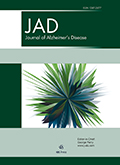Authors: Puoyan-Majd, Samira | Parnow, Abdolhossein | Rashno, Masome | Heidarimoghadam, Rashid | Komaki, Alireza
Article Type:
Research Article
Abstract:
Background: Oxidative stress plays a major role in the progression of Alzheimer’s disease (AD)-related cognitive deficits. Objective: This study was done to determine the protective effects of coenzyme Q10 (CoQ10) and high-intensity interval training (HIIT) alone and in combination for eight continuous weeks, on oxidative status, cognitive functions, and histological changes in the hippocampus in amyloid-β (Aβ)-induced AD rats. Methods: Ninety male Wistar rats were randomly assigned to the sham, control, Q10 (50 mg/kg of CoQ10; P.O.), HIIT (high intensity: 4 min running at 85–90% VO2max, low intensity: 3 min running at 50–60% VO2max), Q10 + HIIT, AD, AD+Q10, AD+HIIT, and
…AD+Q10 + HIIT groups. Results: The results showed that Aβ injection reduced cognitive functions in the Morris water maze (MWM) test and recognition memory in the novel object recognition test (NORT), which was accompanied by a decrease in total thiol groups, catalase, and glutathione peroxidase activities, an increase in malondialdehyde levels, and neuronal loss in the hippocampus. Interestingly, pretreatment with CoQ10, HIIT, or both, could markedly improve the oxidative status and cognitive decline in the MWM and NOR tests, and hinder neuronal loss in the hippocampus of Aβ-induced AD rats. Conclusion: Therefore, a combination of CoQ10 and HIIT can improve Aβ-related cognitive deficits, probably through an amelioration in hippocampal oxidative status and prevention of neuronal loss.
Show more
Keywords: Alzheimer’s disease, coenzyme Q10, high-intensity interval training, Morris water maze, novel object recognition test, oxidative status, rat
DOI: 10.3233/JAD-230096
Citation: Journal of Alzheimer's Disease,
vol. 99, no. s1, pp. S67-S80, 2024
Price: EUR 27.50




